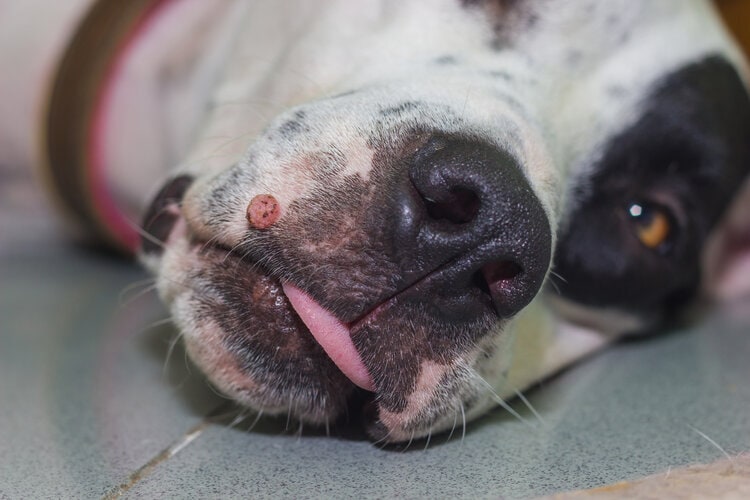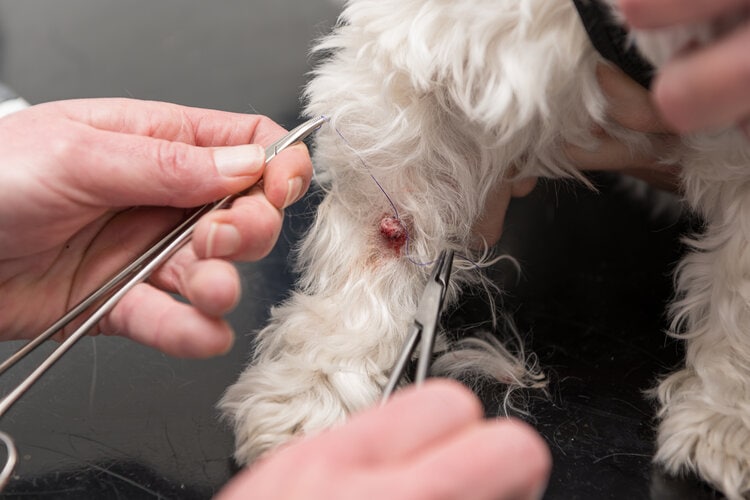
Just like humans, dogs get lumps and bumps on their skin. Many of these growths are harmless, but dogs may also develop skin cancer, and it’s important to understand what’s normal (and what isn’t).
Dogs can grow skin tags on different parts of their bodies, and they’re usually benign. These fibrous growths are more common in older dogs, but they can affect any dog at any age. In most cases, skin tags aren’t anything to worry about unless they grow too big and become uncomfortable for your dog.
What Is a Skin Tag?
A skin tag is a fleshy growth that can appear anywhere on a dog’s body. You’ve likely seen skin tags on people, which are the same color as the surrounding skin and just hang off—they’re the same with dogs.
Skin tags are composed of collagen and blood vessels with skin. They typically start small and may become larger over time. Most of the time, skin tags are painless and benign. They’re only an issue if they bother your dog.
If you discover a growth that looks like a skin tag, it’s important to monitor its size, shape, and color. Watch it to make sure it doesn’t change. It may be helpful to take pictures to keep track of any changes.
When you take your dog in for an exam, mention it to your vet. If it remains unchanged, it can be looked at during your regular vet visits. If it changes, contact your vet, and schedule a checkup.

Skin Tag Signs
Skin tags may be soft, skin-colored bumps or wart-like growths and may be with or without hair. Several growths may show in the same spot. They could also grow outward and dangle a bit, which is more indicative of a skin tag and not another type of growth.
What Causes Skin Tags?
Is It a Skin Tag or Something Else?
Skin tags can mimic other growths or problems, such as nipples, ticks, tumors, or warts. If you’re concerned about the look of the skin tag, schedule an appointment for an examination from your vet. Depending on the nature of the growth, your vet may schedule further testing or suggest removing the skin tag to avoid problems.
Skin tags are often confused with nipples. One easy way to tell the difference between a skin tag or a nipple is to look at the other side. Both male and female dogs have 8–10 nipples that are roughly in the same spot on each side. If you see what you think is a skin tag with a matching one on the other side, it’s probably a nipple.
Warts may also resemble skin tags. They’re caused by a virus and contagious, so they can spread between dogs but not to humans or other pets. Warts may disappear and reappear regularly and may be round or cauliflower-like in appearance.

If you suspect a skin tag is a tick, you want to remove it, but be cautious. Trying to pull off a skin tag will be painful for your dog. Ticks are smooth, round, and shiny, especially as they become engorged with blood. If you look closely, you may be able to see the tick’s legs close to the skin.
Finally, some cancerous tumors can look like skin tags. While there’s no cause for immediate concern, it’s important to pay attention to any changes and let your vet know about the growth. A great way to document and notice if there is any change over time is to take a picture of the mass next to a ruler.
How Are Skin Tags Treated?
Skin tags may annoy you or your dog, but you should never try to remove them yourself. Pulling on a skin tag is uncomfortable for your dog, not to mention that you can cause an infection or irritation that makes matters worse. In most cases, skin tags are harmless and don’t require treatment. If the skin tag bothers your dog, which may happen if it grows larger or occurs in an area that experiences frequent friction, like the collar, you can choose to have it removed.
If a skin tag is removed, it may be sent to a pathologist for analysis to determine what it is or its underlying cause.

Conclusion
Skin tags are one of many possible skin growths your dog can develop. Fortunately, skin tags are typically harmless, but they may become a nuisance for your dog if they grow too big. Skin tags can also mimic other conditions, such as ticks or cancerous tumors, so it’s important to let your vet know and keep an eye on the growth’s size and color.
Featured Image Credit: Nishizuka, Pexels








